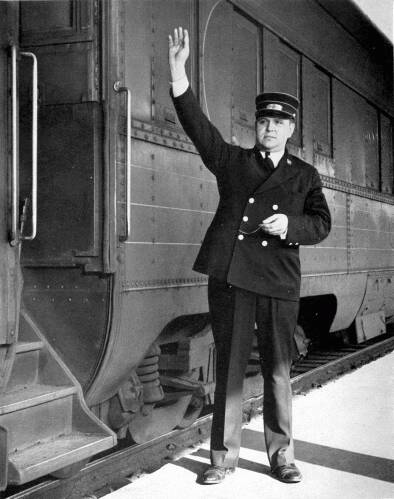|
The Conductor Signals "All Aboard"
 Probably no man in railway service
comes in contact with more people or travels any farther in the
course of a year than the conductor of a passenger train. Probably no man in railway service
comes in contact with more people or travels any farther in the
course of a year than the conductor of a passenger train.
What the captain is to the steamship, the conductor is to the
railway train. He is responsible for carrying out all orders pertaining
to the operation of his train, for the conduct of his crew, for
the comfort and safety of passengers and for the collection of
tickets and fares. He sees that his train displays the proper
flags or lights and that each member of the train crew performs
his duties according to well-established rules.
The conductor is under the supervision of and reports to the
superintendent or the trainmaster of his division He reports for
work sufficiently in advance of the scheduled time of departure
to see that his train is properly made up and inspected and that
other members of the crew are on duty Before leaving the terminal,
the conductor inspects his train to see that the cars are clean,
that there is fresh water in the coolers and that the temperature
in the cars is properly regulated.
After the train is on its way, the conductor collects tickets
and fares from passengers taking short trips and punches the tickets
of other passengers who may be stopping off along the way, or
going to another part of the railroad, or traveling over other
railroads. At the end of his run, the conductor makes a detailed
report of his ticket and cash receipts, and these are carefully
checked later by the auditor's office.
Members of the passenger train crew who are under the conductor's
supervision include an engineer, a fireman, one or more brakemen
(sometimes called trainmen or flagmen), a baggageman if the train
carries a baggage car, and on some railroads a porter for the
coaches. The Pullman conductor, Pullman porters and dining car
crew are also under the general supervision of the conductor.
The brakemen and the porters assist the conductor by announcing
stations, opening and closing vestibule doors at the stations,
helping passengers on and off trains with their baggage and performing
such other duties as the conductor may direct.
Every train makes its run under specific orders as to the time
of departure from each station, the stops to be made, and the
time of arrival at destination. The conductor must see that the
train leaves each station on the exact time specified in his schedule.
Under no circumstances is the train allowed to leave a station
ahead of schedule. If the train should be delayed en route, it
must proceed to its destination in accordance with definite instructions
from the train dispatcher's office.
The conductor is responsible for carrying out these instructions.
Train orders are addressed jointly to the conductor and engineer,
but the engineer is governed by the directions of the conductor
so far as train movements are concerned.
Before a man can qualify for the position of conductor, he
must serve for years as a brakeman; he must be thoroughly familiar
with operating rules and practices, and he must have demonstrated
that he is a man of sound judgment and good habits. His first
years as a conductor are usually in freight yard switching service,
later he is advanced to regular freight train service and still
later to a passenger run.
The star on the conductor's sleeve in the picture indicates
the number of years he has been a railroad employee.
Conductors and other members of the train crew must have good
health and excellent eyesight in order to qualify for their positions.
Physical examinations, eye tests and hearing tests are made at
intervals to make certain that the men are fully qualified to
perform their duties.
I've Been Working
on the Railroad | Contents Page
|







